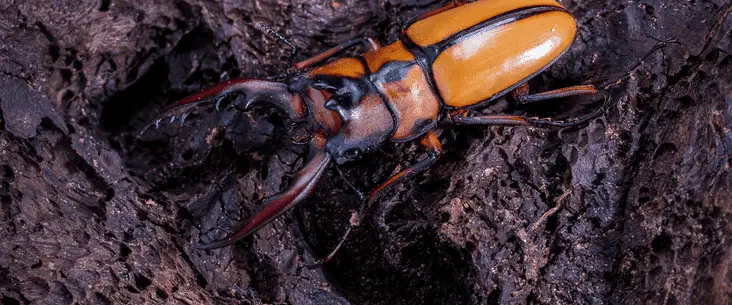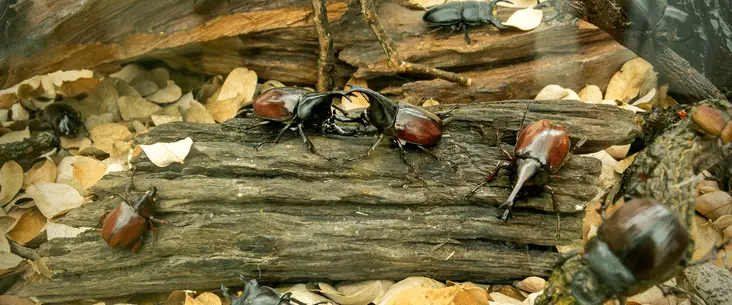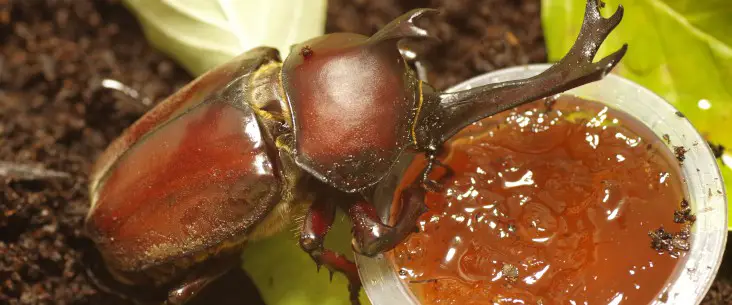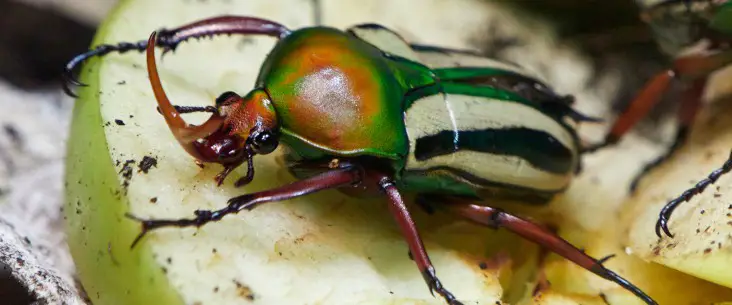
On this page, we will discuss the general care for pet beetles. There are thousands of beetles in the world, and many of them are kept as a pet. Although some beetles have specific needs, many aspects can be generally applied. You can see this page as an umbrella guide discussing the most fundamental features of caring for pet beetles.
For practical reasons we can divide the more popular beetles into three main subgroups:
- Flower beetles (Cetoniinae spp.)
- Stag beetles (Lucanidae spp.)
- Rhinoceros beetles (Dynastinae spp.)
Rhinoceros and stag beetles have gained its popularity because of its large size and strange shapes. Flower beetles are popular because of their colour, one more stunning than the other. In general, beetles are rather easy to keep and care for, although it is important to set up some aspects properly.
The life-cycle of beetles exist of four stages: eggs, larvae (three growth stages), pupae and adult. I have split this care guide into three sections. First, we discuss the care for beetle larvae. Next, we will look at beetle pupae, and we end discussing how to provide the best care for adult beetles.

Caring for beetle larvae (grubs)
We start with the care for beetle larvae — also called grubs. Beetles have a quite long larval stage, where they mostly eat and grow in preparation for the metamorphosis into a beetle. Raising grubs is quite easy when you have it set up right.
Housing beetle larvae
Housing beetle larvae is rather simple. All you need is a plastic container and a suitable substrate. For some flower beetles you can even house it all in one enclosure if the enclosure is large enough, and when the substrate is thick enough (more on that later). Never house stag beetle larvae together, they can be cannibalistic.
Enclosure type
You can house beetle larvae in a small plastic container. This is especially useful when raising stag beetle and rhinoceros beetle larvae. For them, it is best to house the larvae separately. For flower beetles, you can house them in one container.
You can use something as simple as a plastic Tupperware container or deli container. At least pick something that has a lid included. A lid keeps the humidity higher inside the enclosure. For larger species, it is recommended that you take a container that has lids that can be locked (screwed lids or other locking mechanisms). Large beetle larvae are quite strong, and some otherwise may open a lid. If a beetle larvae escapes, it will quickly dry out.
Make sure that you have some ventilation holes in the lid of the container to create an airflow. Don’t make too many holes and don’t make them too large. Although will not crawl out easily, it will increase the evaporation of moisture, and make your substrate dry out quicker. When drilling the holes sand down sharp edges. Or use a hot needle to make several holes.
When you have a large enclosure for your flower beetles (or you planning to buy a large enclosure), you can raise grubs inside the substrate of your adult’s enclosure.
Container size
What size do you need to pick? This highly depends on the species. Also, it is more on the needed volume of the substrate that determines what size container you need. In the table below, you will find the minimum recommended volumes needed to raise grubs and consequently minimum recommended container size for each beetle larvae.
| Growth stage | Flower beetles | Stag beetles | Rhino beetles |
|---|---|---|---|
| L1 | 50 ml | 75 ml | 100 ml |
| L2 | 100 ml | 150 ml | 200 ml |
| L3 | 1000 ml | 1500 ml | 2000 ml |
| Recommended minimum container size | 10cm x 10cm x 10cm (4″ x 4″ x 4″) | 15cm x 10cm x 10cm (6″ x 4″ x 4″) | 20cm x 10cm x 10cm (8″ x 4″ x 4″) |
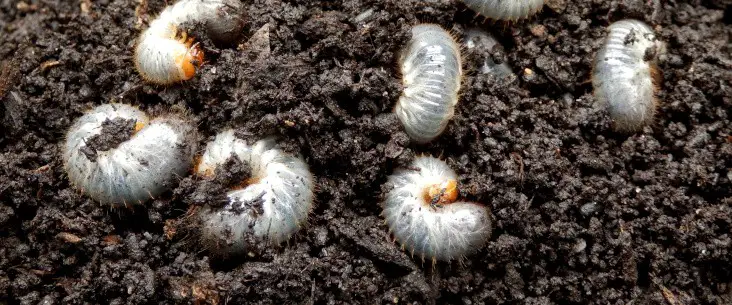
Substrate
The substrate is life for beetles. The substrate is one of the most important features when keeping beetles. For larvae, it is a place to feed, rest, grow, be protected and to develop into pupae. Larvae won’t leave the safety and comfort of the substrate. It is therefore important to provide a good quality substrate.
The substrate has a base component and a food component. The filler is to create volume. The food component is what is says — it provides food for the larvae.
The substrate may consist of leaf litter, decaying wood and a filler (coconut fibre or potting soil). It depends on the species which substrate is most recommended. It is a safe combination to place all three products and mix them together — flower beetles like leaf litter more, where rhino and stag beetles are favouring decayed wood.
When collecting leaf litter and/or decayed wood, choose those of hardwood tree species. Softwood trees and pine trees contain resinous sap and are of less quality for beetle larvae. For leaf litter, collect the layer below the top that is a bit more decayed (almost flakes). For decayed wood, find wood that is white and really soft (broken down by white-rot fungi). It needs to be so soft that you can scrape pieces off with a fingernail.
Ambient environment
Although the substrate is an important feature for raising beetle larvae, you should also control the ambient environment, which means to maintain a proper humidity and temperature. However, every beetle larvae have its own optimum temperature and humidity range wherein they thrive. But there are some general practices and tips that can be applied to every beetle species.
Humidity
The humidity is regulated by spraying moisture on the substrate. The substrate always needs to be damp. It is of utmost importance that the substrate always contains moisture. The substrate should never dry out, nor should it be kept too wet.
You don’t necessarily need to spray it daily, but should be at least sprayed when the top layer almost dried out. Best is to use a small mist spray bottle. Beetle larvae will be kept hydrated by the moist substrate they eat. You don’t have to provide an additional water source.
When the substrate is too moist, it is more likely for bacteria and fungi to grow. When you see mould grow spot clean the substrate.
Temperature
The optimal temperature highly depends on the species. Where certain species like it a bit cooler between 15°C and 20°C (59°F-68°F), other species like it a bit warmer around 20°C to 25°C (68°F-77°F). It is difficult to get a unified recommendation for the best temperature range for beetle larvae
Therefore, always check the needs for the specific species what the recommended temperature range is. Do your own research and check multiple sources (don’t blindly trust only one source).
Most beetle flower beetles like it warmer, and it is safe to place them within the temperature range of 25°C and 28°C (77°F-82°F)
Feeding beetle larvae
Grubs are detritivores — they feed on decaying organic matter. Some beetle larvae feed on other food items, but for the species normally kept as a pet (and that we discuss in this care guide), they feed on the food component in the substrate.
We already discussed what you need for the substrate: a filler where you add a food component, like leaf litter and decaying wood. What is best for your beetles depends on the species.
And that is essentially it. You don’t need any additional food than a good quality substrate. That makes it quite simple to keep grubs. However, some grub species can value additional food like a dry cat or dog pellet. Although it will add extra nutrients to your beetle larvae diet, it is also a source that can quickly become mouldy. Grubs like to pull pellets in the ground, and that makes it difficult to find and get out after a few days. Remember, if you have a good substrate, you don’t need any additional food.
Cleaning
Beetle larvae are eating machines. And what goes in also comes out, right? Grubs can make a mess of it, and you need to clean the container ones in a while. Cleaning is there for two reasons: 1. you take out faeces and 2. you add new food substrate for them.
The excrement of beetle larvae looks like small hard/compact pellets, although some grubs can make rather large pellets. When you see a lot of these faecal pellets, it is time to clean the container.
However, it is important not to refresh all substrate at ones. Grubs can have difficulty to adapt to the new fresh substrate, so best is to leave some of the old substrate in the enclosure. You can clean the container following these 6 easy steps:
- Carefully tip out all the old substrate
- Keep the old substrate for now
- Fill ⅓ of the container with the old substrate
- Fill ⅔ (the rest) of the container with new fresh substrate. You don’t have to mix the two layers
- Make a small hole and place the grub back in its container
- Mist spray the new substrate to make it damp (if is not already damp)
That’s easy, right! It would be good between substrate changes to remove visible faeces pellets, but don’t dig for them and unnecessarily disturb the larvae.
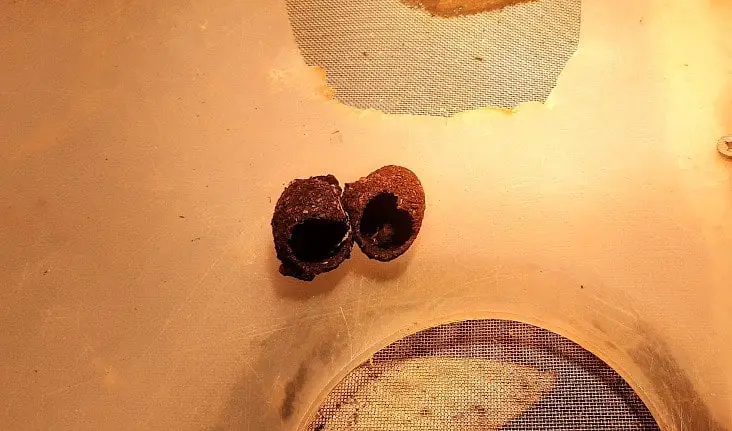
Caring for beetle pupae
If you take good care of your beetle larvae, it will eventually transform into a pupa. At that moment, it is important actually to don’t do anything special, just be patient and wait for the beetle to emerge.
They can be housed in the same environment (temperature & humidity) as they did as larvae. Also, don’t disturb them and leave them on the spot where they decided to pupate. Many beetle larvae species that pupate will build a cocoon of sand, which protect the pupa.
However, it is important to keep up the humidity and spray the substrate once in a while to keep it damp; otherwise, the pupa will dry out.
Caring for adult beetles (imago)
In this section, we discuss the care of adult beetles, from the time they are newly emerged. We focus here on the care for them as a pet to observe and enjoy. When you wish to breed with them, you should check out the section about breeding beetles.
Housing adult beetles
Adult beetles are housed differently than larvae. Beetles are living mostly above ground, and you will enjoy it more when you have an enclosure that has better visibility. Generally, you can use a plastic or glass terrarium for housing your beetles.
I like it to have enclosure with a bit more height than surface, because beetles like to climb on objects and with a (heating) lamp, they can decide how high they want to sit. Beetles will also do attempts to fly when they are mature, so some height is desirable.
Enclosure size
The size of the enclosure depends on the species. A general rule is to have an enclosure that is around 5 times the body length in width and at least 5 times the body length in height. Beetles enjoy some space, so bigger enclosure are better to have. For flower beetles, it is desirable to have a higher enclosure because they will make more fly attempts.
| Beetle species | Recommended size |
|---|---|
| Flower beetles | 30cm x 30cm x 45cm (12″ x 12″ x 18″) |
| Stag beetles | 60cm x 45cm x 60cm (24″ x 18″ x 24″) |
| Rhinoceros beetles | 60cm x 45cm x 60cm (24″ x 18″ x 24″) |
Substrate
Substrate is not as important for adult beetles as for larvae. A substrate layer of 5 cm (2″) is sufficient for them. It also doesn’t have to contain a food component, so you can use regular potting soil or coconut fibre for them. But it is also fine to use the same substrate as you do for the larvae.
Make the substrate compact and form and place some (rotten) leaves onto it. The substrate should be kept moist and dump, but avoid making it soaking wet.
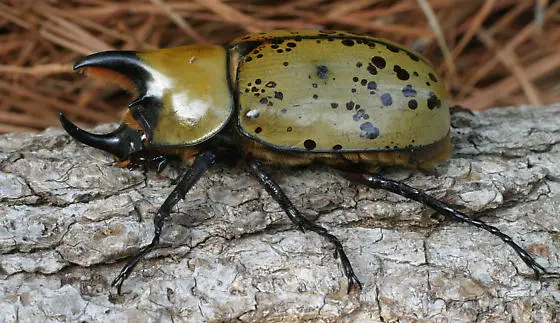
Furnishing and decoration
When you have placed they substrate you should place som twigs, branches and/or pieces of rotten (lightweight) wood. Not only do these items make the enclosure visual more attractive, but they are also beneficial for your beetles. Beetles like to climb or find the right height to warm up.
The other reason it is important to place perches into the enclosure is that when a beetle has flipped over, it is difficult for them to get back right up. You can compare it with a turtle. Many beetles don’t have large enough legs to touch the ground when laying on its back. With the help of some branches and objects, they can find the grip to flip right back.
Beetles don’t have many other requirements. But you can use some decoration to make your enclosure more appealing. You can place some live plants; however, they probably won’t survive for long, because beetles may destroy it (depending on the plant species). Moss works really well and also benefits the humidity, and it looks great too!
Don’t use rocks, pebbles or any heavy objects. When a beetle decides to dig in, they can become crushed under such an object.
Ambient environment
Almost all beetles kept as pets like a humid environment. Keep your substrate damp by frequently mist spraying it with water. It keeps your beetles hydrated and maintains the humidity. Don’t overdo it though, beetles don’t like soaking wet substrate, but fungi and bacteria do and will start to grow rapidly.
Temperature requirements differ for different beetles species. Flower beetles generally like it quite warm, around 25°C up to 28°C (77°F-82°F). A simple 35W to 50W light bulb will give enough warmth for those beetles. Most other beetles are best kept at normal room temperature, around 20°C (68°F). To give them some light, you can place a LED light above the enclosure or place a normal light bulb further away from the enclosure.
You can place the lightbulb on a timer and set it to a 12h:12h light cycle. This way, it can cool down at nights. It is good to have some temperature fluctuation between day and night. If it gets too cold at night, you could place a small heat mat below or on the back of the enclosure to provide some heat.
Like with beetle larvae, never place the enclosure of adult beetles in direct sunlight. If you do, it can quickly become too hot, overheating and stressing the beetles.
Feeding beetles
Although there are beetles that eat other stuff, most beetles kept as pet can be fed sweets: fruits and (commercial) beetle jelly. Many adult beetles feed on sweet tree sap in heir natural habitat. We substitute this for bananas, melons and apples. Beetle jelly is a commercial product to feed to your beetles and is very well accepted.
Avoid products like leafy greens and acidic fruits (like lemons and oranges). Vegetables and greens are not well eaten. Acidic fruits are eaten, but can damage your beetle because the acidity of these fruits.
Place the food on a plate or low-edged food bowl at an open spot in the enclosure. Avoid placing the food beneath the heating source, because it will dry out the food more quickly. Beetles will gain all needed moisture from their food unless it is completely dry out.
Be aware that fruits, together with a humid and warm climate, can attract fruit flies. This can become a serious pest. Fruit flies do not favour beetle jelly, so it is wise to feed that if you have problems with fruit flies. You can then feed fruits occasionally.
Cleaning
Cleaning is almost effortless. Adult beetles don’t make much mess. You only have to spot clean dirty spots in the enclosure once in a while and remove uneaten food items. Always remove food items within 48 hours; otherwise, it becomes mouldy. Extensive mould is harmful to your beetles.
Because beetles are so easy to keep is one of the reasons why many people like them to have as pets.
Share this page!

